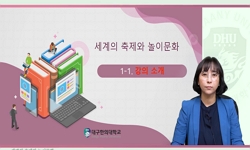원주오리골농요는 지금의 원주시 행구동 신월랑과 반곡동의 오리골, 봉대, 뒷골, 영랑, 입춘내 등지에서 불리던 소리로 신세타령, 갈꺽기소리, 원주어리랑, 모심기소리, 김매기소리 등이 있...
http://chineseinput.net/에서 pinyin(병음)방식으로 중국어를 변환할 수 있습니다.
변환된 중국어를 복사하여 사용하시면 됩니다.
- 中文 을 입력하시려면 zhongwen을 입력하시고 space를누르시면됩니다.
- 北京 을 입력하시려면 beijing을 입력하시고 space를 누르시면 됩니다.
<원주어리랑>과 원주오리골농요 연구 -연출을 중심으로- = A Study on < Wonju Eorirang > and Wonju Origol Farming Songs -Focusing on Directing-
한글로보기https://www.riss.kr/link?id=A108077915
- 저자
- 발행기관
- 학술지명
- 권호사항
-
발행연도
2019
-
작성언어
-
-
주제어
원주어리랑 ; 원주오리골농요 ; 박희완 ; 연행 ; 연출 ; 축제 ; Wonju Eorirang ; Wonju Origol Farming Songs ; Park ; Hee-Wan ; Performance ; Directing ; Festival
-
자료형태
학술저널
-
수록면
121-144(24쪽)
- 제공처
-
0
상세조회 -
0
다운로드
부가정보
국문 초록 (Abstract)
원주오리골농요는 연구자 남강연이 농자천하지대본을 바탕으로 스토리텔링하여 민속작품으로 재현 연출, 2015년 제26회 강원민속예술축제에서 우수상, 2017년 제58회 한국민속예술축제에서 동상을 수상하였다. 원주오리골농요는 예전에 비료나 거름 등이 부족하여 산에서 갈을 뜯어 거름으로 사용하던 시절이 있었는데 그때 부르던 농요이다. 원주는 행구동, 흥업면, 호저면 등 여러 지역에서 갈을 뜯어 논농사의 거름으로 사용하였다. 원주어리랑을 비롯하여 원주오리골농요는 원주지역의 민속예술작품으로 보전 전승되어야 한다.
원주오리골농요는 지금의 원주시 행구동 신월랑과 반곡동의 오리골, 봉대, 뒷골, 영랑, 입춘내 등지에서 불리던 소리로 신세타령, 갈꺽기소리, 원주어리랑, 모심기소리, 김매기소리 등이 있다. 원주오리골농요는 농악이 성행 하였던 행구동과 반곡동 인근 마을 주민들이 모여서 농악과 함께 이러한 농요를 불렀다. 박희완은 원주어리랑을 비롯하여 이러한 농요를 기억하고 계시는 분으로 입춘내에 살았다. 그는 오리골 농악에서 태평소를 연주하며 근 30여 년 활동 하였으며 지역에서 위와 같은 소리를 ‘원주오리골농요’라 불려지게 되었다.
원주오리골농요는 연구자 남강연이 농자천하지대본을 바탕으로 스토리텔링하여 민속작품으로 재현 연출, 2015년 제26회 강원민속예술축제에서 우수상, 2017년 제58회 한국민속예술축제에서 동상을 수상하였다. 원주오리골농요는 예전에 비료나 거름 등이 부족하여 산에서 갈을 뜯어 거름으로 사용하던 시절이 있었는데 그때 부르던 농요이다. 원주는 행구동, 흥업면, 호저면 등 여러 지역에서 갈을 뜯어 논농사의 거름으로 사용하였다. 원주어리랑을 비롯하여 원주오리골농요는 원주지역의 민속예술작품으로 보전 전승되어야 한다.
다국어 초록 (Multilingual Abstract)
The Wonju Origol Farming Songs were represented/directed as a folk work by the researcher Nam, Gang-Yeon through storytelling based on the ‘Agriculture is the prop of the country’. They received the excellence award at the 26th Gangwon Folk Arts Festival in 2015, and the bronze prize at the 58th Korean Folk Arts Festival in 2017. The Wonju Origol Farming Songs were sung when collecting reeds from mountain to use them as fertilizer. In many areas of Wonju such as Haenggu-dong, Heungeop-myeon, and Hojeo-myeon, the reeds were used as fertilizer of rice farming. The Wonju Origol Farming Songs including Wonju Eorirang should be preserved and inherited as a folk artistic work of Wonju region.
As the songs enjoyed in Origol, Bongdae, Doitgol, Yeongrang, and Ipchunnae of Bangok-dong, and Sinwolrang of Haenggu-dong in the current Wonju-si, the Wonju Origol Farming Songs include the Sinsetaryeong(one’s hard-luck story), Galggeokgi-Song, Wonj...
As the songs enjoyed in Origol, Bongdae, Doitgol, Yeongrang, and Ipchunnae of Bangok-dong, and Sinwolrang of Haenggu-dong in the current Wonju-si, the Wonju Origol Farming Songs include the Sinsetaryeong(one’s hard-luck story), Galggeokgi-Song, Wonju Eorirang, Rice Planting Song, and Weeding Song. The Wonju Origol Farming Songs were sung together with Nongak(Korean traditional farming music) by village residents around Haenggu-dong and Bangok-dong where the Nongak was popular. As a person who remembered these farming songs including Wonju Eorirang, Park, Hee-Wan lived in Ipchunnae. He actively performed in the Origol Nongak for almost 30 years by playing the Taepyeongso. And the songs above have been called ‘Wonju Origol Farming Songs’ in this region.
The Wonju Origol Farming Songs were represented/directed as a folk work by the researcher Nam, Gang-Yeon through storytelling based on the ‘Agriculture is the prop of the country’. They received the excellence award at the 26th Gangwon Folk Arts Festival in 2015, and the bronze prize at the 58th Korean Folk Arts Festival in 2017. The Wonju Origol Farming Songs were sung when collecting reeds from mountain to use them as fertilizer. In many areas of Wonju such as Haenggu-dong, Heungeop-myeon, and Hojeo-myeon, the reeds were used as fertilizer of rice farming. The Wonju Origol Farming Songs including Wonju Eorirang should be preserved and inherited as a folk artistic work of Wonju region.
동일학술지(권/호) 다른 논문
-
- 세명대학교 지역문화연구소
- 고광호 ( Ko Kwang-ho )
- 2019
-
- 세명대학교 지역문화연구소
- 유상진 ( Yoo Sang-jin )
- 2019
-
- 세명대학교 지역문화연구소
- 원광희 ( Won Kwang-hee )
- 2019
-
- 세명대학교 지역문화연구소
- 방영심 ( Bang Young-sim )
- 2019




 KISS
KISS






